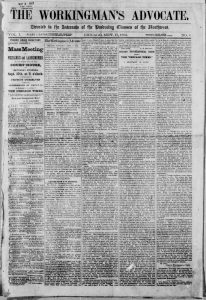The Workingman’s Advocate was established in the fall of 1864 by members of the Chicago Typographical Union. At the time, the union was striking against the Chicago Times, and the union felt the strike was receiving unfair coverage in the local press. Even newspapers traditionally hostile to the Times, like the Chicago Tribune, opposed the strike, because a strike at any newspaper might foment discontent among workers at all newspapers. The union responded by publishing its own newspaper, a move the Typographical Union was uniquely positioned to make since it drew its membership from the very trades that specialized in printing newspapers. The earliest issues of the Workingman’s Advocate therefore reported most heavily on the union’s conflict with the Times.

The Workingman’s Advocate claimed to be “devoted exclusively to the interests of the producing classes of the Northwest,” but actually published a large amount of general interest content unrelated to the labor movement, possibly a sign that the editors, although experts on the printing side of newspaper publishing, struggled with news-gathering, compelling them to rely on so-called “evergreen” content. Evergreen content was a staple of over-extended newspaper editors everywhere. Examples of evergreen content include poetry, fiction, essays, historical facts, epigrams, wit and wisdom, and reports of sensational or “curious” events that remain interesting long after they occurred. Despite the varying amount of original labor news, historians consider the Workingman’s Advocate to be one of the most important labor newspapers of the 1860s and 1870s, both in terms of its influence on the labor movement, and also as a source of information on that movement.
The union’s strike against the Times ended unsuccessfully in December, and control of the Workingman’s Advocate passed to Andrew Cameron. As an active member of the Typographical Union, and also one of the striking Times employees, Cameron had been involved with the paper from its founding. He had far greater ambition than the original editors, whose scope was more narrowly focused on the union’s strike against the Times. Cameron became prominent in the labor movement nationally, especially in the formation of the National Labor Union (NLU), and he used the Workingman’s Advocate both to advocate for the formation of the NLU, and to report on the process of that formation.
Editorially, the Workingman’s Advocate pushed for major reforms such as producer cooperatives, the eight-hour workday, and the formation of an independent labor party. Cameron believed that only a separate labor party could keep the labor movement independent of the nation’s dominant political parties. He argued that political independence was crucial to the movement’s success. The NLU dissolved in 1873, and in 1874 the Workingman’s Advocate allied itself with the Industrial Congress of the United States. Cameron continued publishing the paper through 1879, when it ceased. He went on to become a founding editor of the Inland Printer, widely considered to be the most important newspaper for the printing trades.
The Workingman’s Advocate was digitized with funding from the National Endowment for the Humanities, as part of the National Digital Newspaper Program.